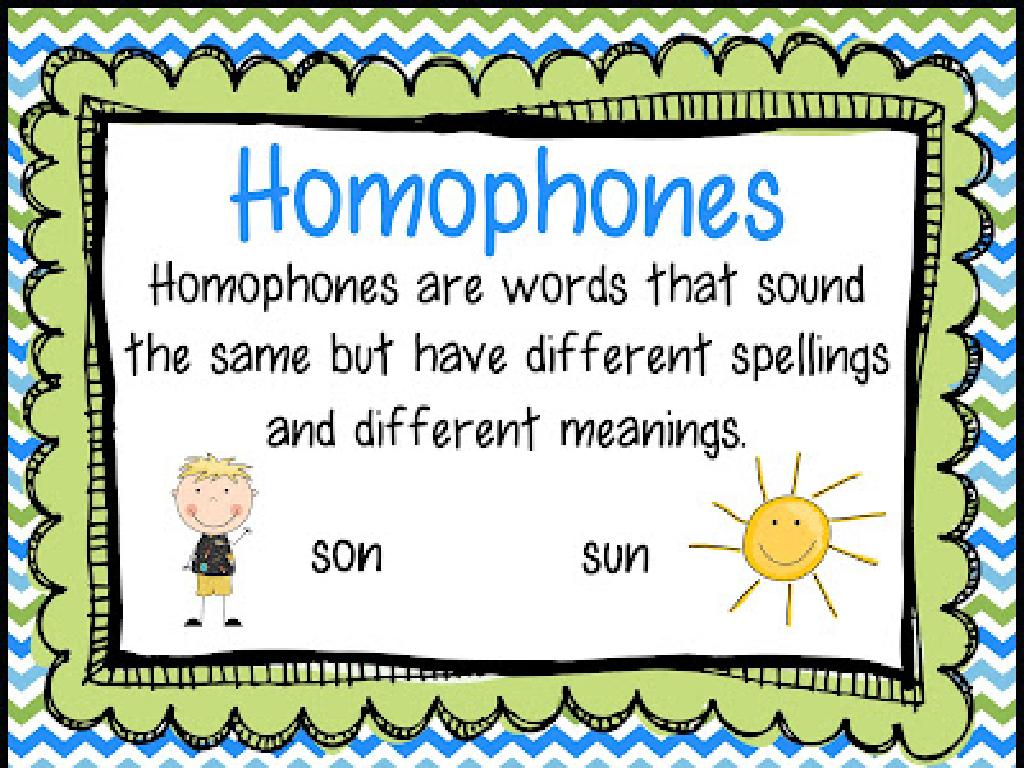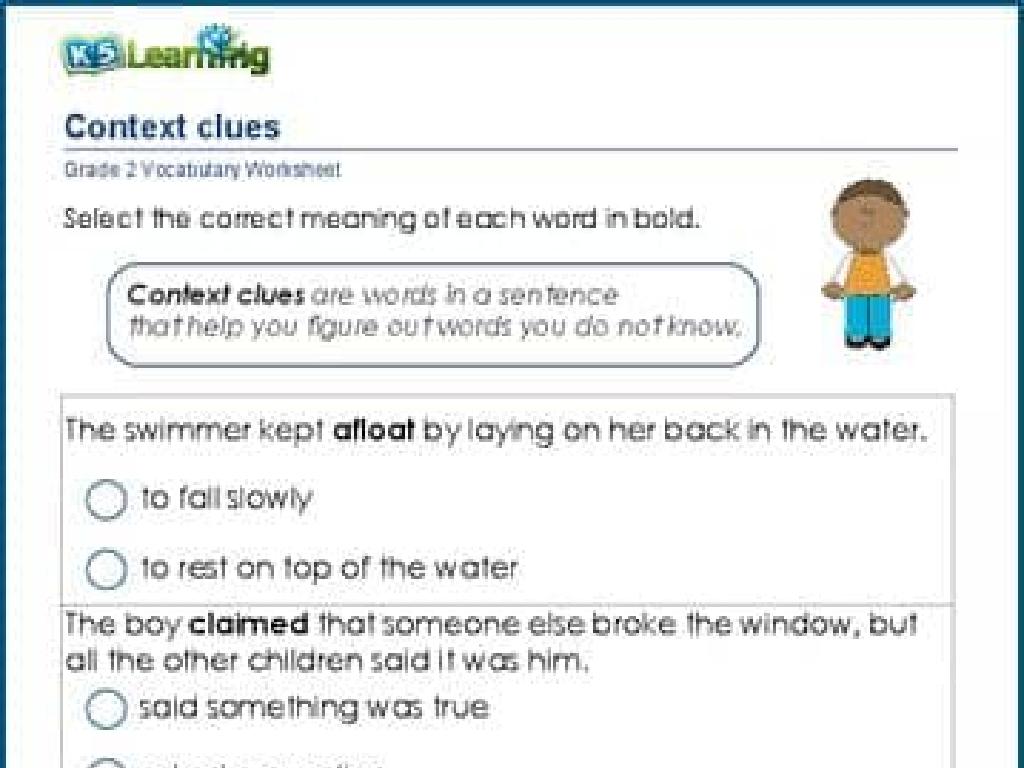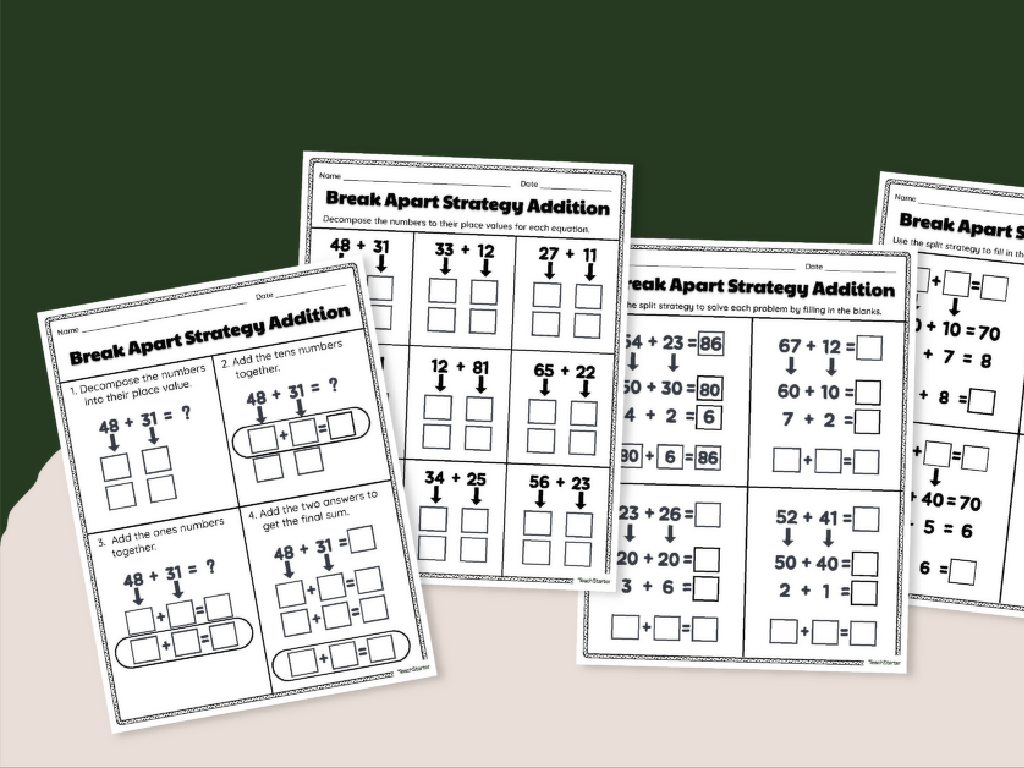Determine The Main Idea Of A Passage
Subject: Language arts
Grade: Fourth grade
Topic: Main Idea
Please LOG IN to download the presentation. Access is available to registered users only.
View More Content
Welcome to Main Ideas!
– Discover the story’s heart
– Define the main idea
– The main idea is what the story is mostly about.
– Importance of main idea
– Helps focus on what’s essential in the text.
– Finding the main idea
– Use details in the story to find the main idea.
|
This slide introduces the concept of the main idea in a story, which is a crucial component of reading comprehension. Start by explaining that the ‘heart of the story’ is another way to describe the main idea – it’s what the story is really about. Then, define the main idea as the central point or the most important thought the author wants to convey. Discuss why identifying the main idea is important: it helps readers understand and remember the key message of the text. Finally, guide students on how to find the main idea by looking for clues in the title, first and last sentences, and other supporting details. Encourage students to practice with examples and to always ask themselves, ‘What is the author trying to tell me?’ while reading.
Discovering Main Ideas in Texts
– Difference between main idea and details
– Main idea is what the text is mostly about; details support it.
– Clues to find the main idea
– Look for repeated words, first & last sentences for hints.
– Main idea in stories
– Like the lesson in a fable or the theme of a chapter.
– Practice with examples
|
This slide aims to help students distinguish between the main idea and supporting details in a text. The main idea is the central point or message that the author wants to convey, while the details are pieces of information that illustrate or explain the main idea. Teach students to look for clues such as titles, topic sentences, and words that appear multiple times. Use examples from familiar stories to show how the main idea can be the moral of the story or the central theme. Encourage students to practice by reading passages and identifying the main idea and supporting details, which will enhance their comprehension skills.
Finding the Main Idea
– Read a passage as a class
– Spot the supporting details
– Details that explain or prove the main point
– Discuss in groups
– Share thoughts and listen to others
– Conclude the main idea
– What is the passage mostly about?
|
This slide is aimed at engaging students in an interactive reading session to determine the main idea of a passage. Start by reading a passage together as a class to ensure all students are on the same page. Next, guide students to identify the supporting details within the text that back up the main idea. Encourage them to underline or highlight these details in the passage. Then, facilitate a group discussion where students can share their thoughts and listen to the perspectives of their classmates. This collaborative effort will help them to better grasp the concept of the main idea. Finally, lead the class to a consensus on what the passage is mostly about. The teacher should prepare a short, age-appropriate passage beforehand and have a few main ideas in mind to steer the discussion if necessary.
Practice Makes Perfect: Finding the Main Idea
– Read a passage individually
– Complete the main idea worksheet
– Look for the big idea in each paragraph
– Discuss your answers with a partner
– Explain how you determined the main idea
– Share what you’ve learned together
– Take turns talking about the main idea
|
This slide is designed to reinforce the concept of identifying the main idea through practice. Students will start by reading a passage on their own, fostering independent comprehension skills. They will then apply what they’ve learned by completing a worksheet designed to help them pinpoint the main idea of the text. Afterward, students will pair up to discuss their findings, allowing them to verbalize their thought process and learn from their peers. This activity not only solidifies their understanding of the main idea but also enhances their communication skills. As a teacher, circulate the room to offer guidance and ensure that each student is on track. Encourage students to support their findings with evidence from the text.
Main Idea in Our Lives
– Using main idea skills daily
– Finding main ideas in daily reading
– Look for the main idea in menus, signs, or game instructions
– Discussing main idea importance
– Why is it important to understand the main point in messages?
– Class activity: Main Idea Hunt
– Find the main idea in a favorite story or article
|
This slide aims to help students apply the concept of finding the main idea beyond the classroom. Encourage them to use these skills when reading anything in their daily lives, such as menus, road signs, or instructions for games. This will help them see the relevance of what they learn in school. Initiate a class discussion on why it’s important to grasp the main idea in various texts, which can lead to better comprehension and communication skills. For the class activity, have students bring in a piece of text from home, like a story or an article, and identify the main idea, supporting it with key details from the text. This practical application reinforces their understanding and demonstrates the value of this skill in everyday life.
Class Activity: Main Idea Detectives
– Break into detective teams
– Each team gets a unique story
– Find the story’s main idea
– Look for clues in the title, first sentence, and key details
– Present your findings to the class
|
In this interactive class activity, students will work in small groups to practice determining the main idea of a passage. Each group, or ‘detective team,’ will receive a different story to analyze. The task for each team is to read their story carefully, discuss among themselves, and use context clues to deduce the main idea. They should consider the title, the opening sentence, and the most repeated or emphasized ideas throughout the story. Once they have agreed on the main idea, each group will present their story and its main idea to the rest of the class. For the teacher: Prepare diverse stories that are suitable for fourth graders, ensure each story has a clear main idea, and provide guidance on how to identify it. Have a list of questions ready to help groups that might struggle, and be prepared to offer hints if necessary.
Wrapping Up: The Main Idea
– Reviewing main idea concepts
– Recap how to find the main idea in texts
– Applying skills across subjects
– Use this skill in science, history, and more
– Time for questions and answers
– Ask any questions you still have about main ideas
|
As we conclude, revisit the key points about identifying the main idea of a passage. Emphasize that this skill is not just for Language Arts but is also valuable in understanding texts in science, social studies, and other subjects. Encourage students to think about how recognizing the main idea can help them grasp the most important information in various contexts. Open the floor for a Q&A session, allowing students to clarify any uncertainties. This will ensure they leave the class with a solid understanding of the concept and its applications.





